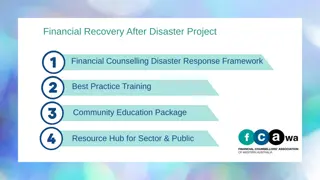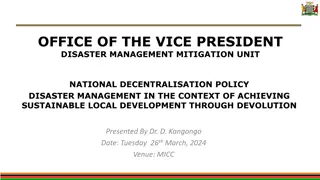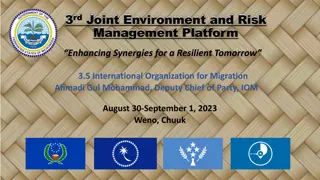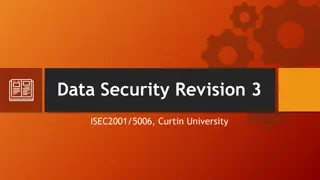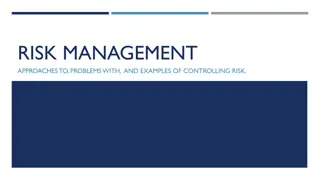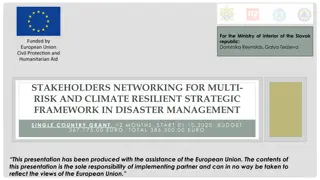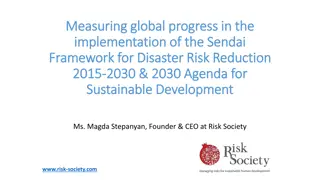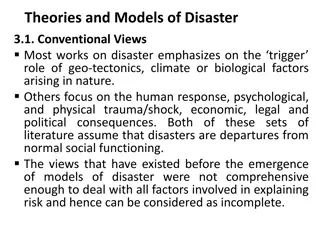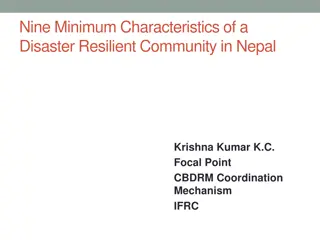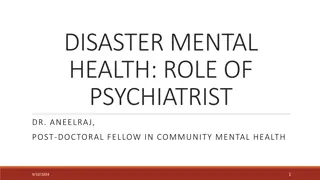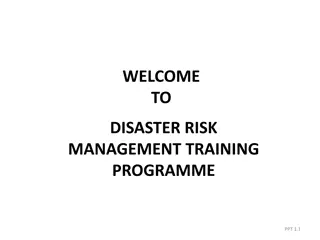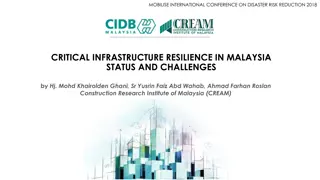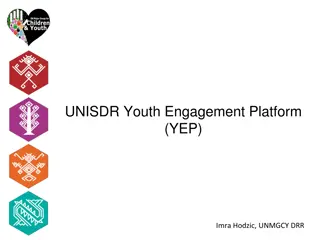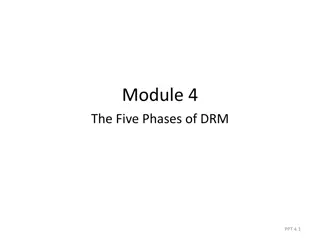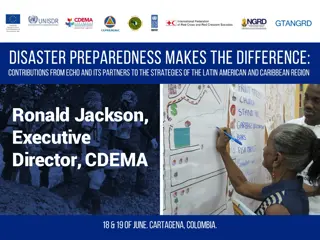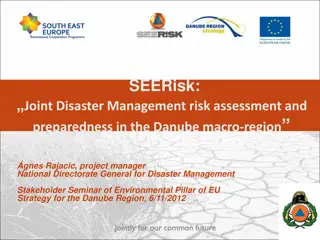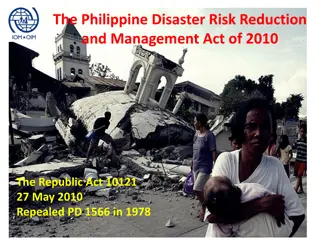International experience in the field of Disaster-related Statistics
Disaster-related statistics encompass data on disaster occurrences, impacts, risk assessment, and post-disaster assessments. The Sendai Framework for Disaster Risk Reduction and the 2030 Agenda for Sustainable Development set global targets and indicators for monitoring disaster risk reduction. Vari
7 views • 6 slides
Understanding Risk Management in Environmental Geography and Disaster Management
Risk management in environmental geography and disaster management involves assessing the potential losses from hazards, evaluating vulnerability and exposure, and implementing strategies to mitigate risks. It includes calculating risk, dealing with risk through acceptance, avoidance, reduction, or
1 views • 10 slides
Understanding Disaster Management Cycle and Phases
Disaster management encompasses planning, organizing, and implementing measures to prevent, reduce, and respond to disasters effectively. The disaster management cycle includes phases such as mitigation, preparedness, response, and recovery. The aim is to reduce potential losses, provide assistance
4 views • 15 slides
Disaster Management and Local Development Through Devolution
The presentation outlined the importance of disaster management in the context of achieving sustainable local development through devolution. It emphasized the need for effective subnational planning, mainstreaming of disaster risk reduction, and financing for disaster relief. The concept of devolut
5 views • 21 slides
Financial Recovery After Disaster Project: Comprehensive Framework for Community Resilience
This project focuses on financial recovery after disasters through financial counseling, disaster response frameworks, best practice training, and community education resources. It emphasizes understanding disaster risk governance, fostering individual responsibility, and identifying community champ
6 views • 5 slides
Understanding the Relationship Between Intangible Cultural Heritage and Disaster Risk Reduction
This PowerPoint presentation by UNESCO explores the connection between Intangible Cultural Heritage (ICH) and Disaster Risk Reduction (DRR). It covers key concepts like disasters, risks, vulnerabilities, and resilience, emphasizing the importance of safeguarding and mobilizing ICH in the face of dis
7 views • 23 slides
Disaster Management and Sustainable Local Development Through Devolution
The presentation explores the integration of disaster management into subnational planning for achieving sustainable local development through devolution. It emphasizes the importance of decentralization, mainstreaming disaster risk reduction, urban areas' resilience, and financing for disaster reli
3 views • 21 slides
Enhancing Synergies for Resilient Tomorrow: Progress and Challenges
Progress has been made since 2018 in enhancing synergies for a resilient tomorrow, including the handover of new houses, public infrastructure projects, and community engagement initiatives. Ongoing projects involve construction, training programs, and disaster risk reduction interventions. Challeng
0 views • 7 slides
Comprehensive Guide to Data Security, Business Continuity, Risk Management, and Disaster Recovery
Explore a detailed overview covering topics such as data security revision, business continuity planning, risk analysis, management strategies, incident prevention, response, recovery, change management, and disaster recovery. Learn about risk assessment, business impact analysis, continuity plans,
0 views • 9 slides
Harm Reduction in Addiction Psychiatry: A Comprehensive Overview
Harm reduction in addiction psychiatry is a client-centered approach that focuses on reducing negative consequences associated with substance use. This philosophy involves practical strategies and principles aimed at promoting safer drug use practices. The historical background traces the evolution
3 views • 40 slides
Disaster Resilience Strategy in Developing Countries Vulnerable to Natural Disasters
The IMF's policy paper highlights key challenges faced by small states in building resilience, such as under-investment and donor support post-disaster rather than pre-disaster. The Disaster Resilience Strategy (DRS) emphasizes three pillars for intervention: post-disaster resilience, financial resi
0 views • 11 slides
Government's Immediate Response to Recent Flood Disaster: Overview and Assessment
Understanding the background and context of the recent flood disaster in KwaZulu-Natal (KZN) and other affected areas, this briefing outlines the government's quick response, including the declaration of a national state of disaster, coordination efforts, and actions taken by various government bodi
1 views • 35 slides
Understanding Risk Management Approaches and Disaster Preparedness
Risk management is a systematic approach to identify, assess, and understand risks to guide management decisions. Perception influences risk management strategies, with varying perceptions between the public and experts. Proactive and reactive approaches help in managing risks effectively. Disaster
2 views • 13 slides
Stakeholders Networking for Multi-Risk and Climate Resilient Disaster Management in Slovakia
This project, funded by the European Union, aims to enhance emergency preparedness and response in Slovakia by addressing institutional capacity, coordination, and technology gaps. The goal is to strengthen risk assessment methodologies, involve various stakeholders, and develop disaster-resilient m
1 views • 5 slides
Global Progress in Disaster Risk Reduction Frameworks
Analyzing the progress in implementing the Sendai Framework for Disaster Risk Reduction (2015-2030) and monitoring achievements under the Hyogo Framework for Action (2005-2015). The focus is on core indicators, national monitoring, conflicting evidence on progress, and issues encountered in monitori
1 views • 23 slides
Understanding Theories and Models of Disaster
Works on disaster traditionally focus on natural triggers and human responses, but older views are considered incomplete. The Pressure-Release Model (PAR) explains vulnerability and risk reduction, highlighting underlying causes and unsafe conditions. Root causes such as economic, demographic, and p
0 views • 17 slides
Building Disaster Resilience: Essential Characteristics of Nepal's Communities
Explore the vital components of disaster resilience in Nepalese communities, including organizational structures, government partnerships, risk reduction strategies, and coordination mechanisms. Discover how key stakeholders collaborate to enhance school and hospital safety, emergency response capac
3 views • 17 slides
Blockchain for Disaster Risk Reduction (DRR) Processes: Enhancing Response and Resilience
Blockchain technology offers a decentralized and transparent approach that can revolutionize Disaster Risk Reduction (DRR) processes. By providing secure and immutable records, blockchain can streamline asset registration, enhance data access control, enable smart contracts, track DRR impact funds,
0 views • 5 slides
Lake Brenton Disaster Mitigation Plan Overview
The Lake Brenton Residents Association plays a crucial role in disaster response with defined responsibilities including being the first responder, securing the area, and coordinating with authorities. The Disaster Mitigation Plan for Lake Brenton outlines roles, organizational structure, procedures
1 views • 20 slides
Understanding the Role of Psychiatrists in Disaster Mental Health
Disaster mental health involves applying psychiatric skills to aid individuals and communities in recovering from the psychological effects of disasters. This includes readiness, response, relief, rehabilitation, recovery, and resilience phases. Mental health professionals play a crucial role in ide
0 views • 30 slides
Disaster Risk Management Training Programme Overview
This presentation provides an overview of a Disaster Risk Management (DRM) Training Programme, aiming to raise awareness about different types of disasters, their impacts, and the importance of having a DRM plan. It includes modules covering topics such as DRM framework, risk assessment, post-disast
0 views • 28 slides
Disaster Risk Reduction and Critical Infrastructure Resilience in Malaysia
International Conference on Disaster Risk Reduction 2018 highlighted the critical need to enhance infrastructure resilience in Malaysia to address challenges and damages caused by natural disasters. The Construction Industry Transformation Programme focuses on sustainable construction practices to m
0 views • 21 slides
Role of Department of ICT in Disaster Risk Reduction in Bangladesh
The Department of Information and Communication Technology (ICT) in Bangladesh plays a crucial role in promoting the use of ICT for disaster risk reduction. Bangladesh faces numerous catastrophic hazards, making it essential to utilize ICT for warning systems, relief management, and post-disaster ac
0 views • 16 slides
Health Impact Assessments for Natural Disaster Recovery
The study examines the status of knowledge related to health impact assessments for natural disaster recovery, emphasizing the importance of considering the long-term health impacts of disasters. It highlights how disasters and recovery actions can have lasting consequences on community health and w
0 views • 10 slides
Organisational Structure of Vietnam Red Cross Society in Disaster Preparedness and Response
The Vietnam Red Cross Society has a structured organizational setup for disaster preparedness and response, including the National Headquarters, Disaster Management Department, and various functional departments at different levels. The organization has achieved significant results in disaster manag
0 views • 6 slides
Understanding Risk Concepts and Management Strategies in Finance
Explore the essential concepts of risk in finance, such as risk definition, risk profiles, financial exposure, and types of financial risks. Learn about risk vs. reward trade-offs, identifying risk profiles, and tools to control financial risk. Understand the balance between risk and return, and the
0 views • 18 slides
Risk Management & MPTF Portfolio Analysis at Programme Level for UN Somalia
This session delves into the world of risk management and portfolio analysis at the programme/project level, specifically focusing on the Risk Management Unit of the United Nations Somalia. It covers enterprise risk management standards, planned risk management actions, the role of RMU, joint risk m
0 views • 30 slides
Global Initiatives for Disaster Risk Reduction in Gandhinagar
The Disaster Risk Reduction Working Group (DRRWG) in Gandhinagar, Gujarat, is focusing on priorities such as early warning systems, resilient infrastructure, financing, disaster response, and recovery. There is a strong emphasis on the connection between disaster risk reduction and sustainable devel
0 views • 18 slides
Integrating Disaster Risk Reduction into ICH Inventorying for UNESCO
Learn how to apply a community-based approach to inventorying and safeguarding intangible cultural heritage within the context of disasters. This presentation offers frameworks, tools, and exercises to integrate disaster awareness into ICH inventorying and safeguarding practices, emphasizing the imp
0 views • 15 slides
Understanding Disaster Risk and Insurance Implications in A.NZ Perspective
Explore the complexities of disaster risk management, insurance implications, and the human dimension within the context of A.NZ perspective. Discover insights on measuring risk, insurance caveats, and the challenges posed by climate change. Delve into the co-benefits of effective disaster risk miti
0 views • 9 slides
Enhancing Flood Disaster Management through Integrated River Basin Approach
Explore the framework for effective Flood Disaster Management through a holistic approach, focusing on river basins' characteristics, environmental impacts, flood triggers, and sustainable solutions. Emphasizing the importance of urbanization management and governance for Disaster Risk Reduction to
3 views • 24 slides
Disaster Health Information Outreach and Collaboration Projects: Enhancing Disaster Preparedness
This project by the National Library of Medicine aims to improve access to disaster medicine and public health information for the disaster health workforce through partnerships with various organizations across the United States. Seven projects are awarded annually, focusing on enhancing disaster p
0 views • 15 slides
Building Disaster Resilient Societies: Progress, Challenges, and the Way Forward
The discourse delves into the current landscape of disaster risk, the status of the Sendai Framework Targets, global DRR challenges identified during the Mid-term Review Process, and the proposed way forward for enhancing disaster resilience. It emphasizes shifting focus towards prevention and risk
0 views • 7 slides
Developing a Risk Appetite Culture: Importance and Framework
Risk management plays a critical role in the success of corporations, with strategy and risk being intertwined. This presentation delves into definitions of key terms such as risk appetite, the Risk Appetite Cycle, characteristics of a well-defined risk appetite, and the importance of expressing ris
0 views • 31 slides
Integrating Climate Change Adaptation in Disaster Risk Reduction Module 1
Welcome to the e-Learning module on integrating climate change adaptation in disaster risk reduction. This module covers concepts in disaster risk reduction and climate change adaptation. It is part of a package that includes five modules focusing on vulnerability, disaster risk reduction, climate c
0 views • 29 slides
UNISDR Youth Engagement Platform: Empowering Young People in Disaster Risk Reduction
The UNISDR Youth Engagement Platform (YEP), led by Imra Hodzic from UNMGCY DRR, aims to involve young individuals in disaster risk reduction efforts. Through four main streams - Capacity Building, Policy & Advocacy, Youth Action, and Knowledge - YEP provides opportunities for youth-led initiatives,
0 views • 7 slides
Understanding the Five Phases of Disaster Risk Management
This presentation covers the five phases of Disaster Risk Management (DRM) which include Risk Prevention, Mitigation, Preparedness, Response, and Recovery. It explains the objectives and activities in each phase, emphasizing the importance of training in preparing for and responding to disasters eff
0 views • 35 slides
Disaster Risk Management Strategies in the Caribbean: Ronald Jackson's Vision
Ronald Jackson, Executive Director of CDEMA, outlines a regional goal to create safer, resilient, and sustainable Caribbean states through knowledge management, institutional strengthening, sector integration, and community resilience. His contributions to the CDM strategy focus on disaster risk red
0 views • 10 slides
SEERisk: Disaster Management and Preparedness in the Danube Macro-Region
Joint Disaster Management project SEERisk aimed to assess and enhance preparedness in the Danube macro-region, involving multiple stakeholders in environmental disaster risk reduction. The project, led by gnes Rajacic, Project Manager at the National Directorate General for Disaster Management, focu
0 views • 17 slides
Enhancing Disaster Risk Reduction in the Philippines
The Philippine Disaster Risk Reduction and Management Act of 2010, also known as Republic Act 10121, replaced PD 1566 and introduced a proactive approach to disaster management, focusing on risk reduction and building community resilience. The new law aims to transform and reform disaster response b
0 views • 26 slides




